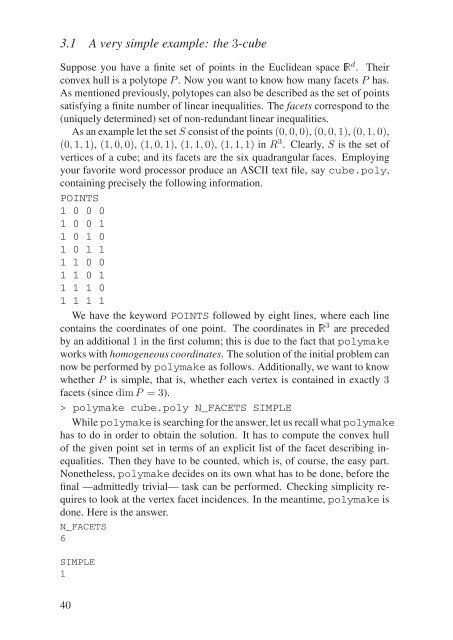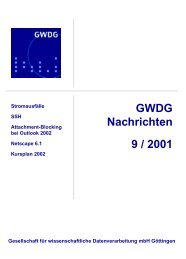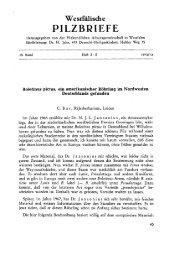Forschung und wissenschaftliches Rechnen - Beiträge zum - GWDG
Forschung und wissenschaftliches Rechnen - Beiträge zum - GWDG
Forschung und wissenschaftliches Rechnen - Beiträge zum - GWDG
Erfolgreiche ePaper selbst erstellen
Machen Sie aus Ihren PDF Publikationen ein blätterbares Flipbook mit unserer einzigartigen Google optimierten e-Paper Software.
3.1 A very simple example: the 3-cube<br />
Suppose you have a finite set of points in the Euclidean space Ê d . Their<br />
convex hull is a polytope P . Now you want to know how many facets P has.<br />
As mentioned previously, polytopes can also be described as the set of points<br />
satisfying a finite number of linear inequalities. The facets correspond to the<br />
(uniquely determined) set of non-red<strong>und</strong>ant linear inequalities.<br />
As an example let the set S consist of the points (0, 0, 0), (0, 0, 1), (0, 1, 0),<br />
(0, 1, 1), (1, 0, 0), (1, 0, 1), (1, 1, 0), (1, 1, 1) in R 3 . Clearly, S is the set of<br />
vertices of a cube; and its facets are the six quadrangular faces. Employing<br />
your favorite word processor produce an ASCII text file, say cube.poly,<br />
containing precisely the following information.<br />
POINTS<br />
1 0 0 0<br />
1 0 0 1<br />
1 0 1 0<br />
1 0 1 1<br />
1 1 0 0<br />
1 1 0 1<br />
1 1 1 0<br />
1 1 1 1<br />
We have the keyword POINTS followed by eight lines, where each line<br />
contains the coordinates of one point. The coordinates in Ê 3 are preceded<br />
by an additional 1 in the first column; this is due to the fact that polymake<br />
works with homogeneous coordinates. The solution of the initial problem can<br />
now be performed by polymake as follows. Additionally, we want to know<br />
whether P is simple, that is, whether each vertex is contained in exactly 3<br />
facets (since dim P =3).<br />
> polymake cube.poly N_FACETS SIMPLE<br />
While polymake is searching for the answer, let us recall what polymake<br />
has to do in order to obtain the solution. It has to compute the convex hull<br />
of the given point set in terms of an explicit list of the facet describing inequalities.<br />
Then they have to be counted, which is, of course, the easy part.<br />
Nonetheless, polymake decides on its own what has to be done, before the<br />
final —admittedly trivial— task can be performed. Checking simplicity requires<br />
to look at the vertex facet incidences. In the meantime, polymake is<br />
done. Here is the answer.<br />
N_FACETS<br />
6<br />
SIMPLE<br />
1<br />
40
















